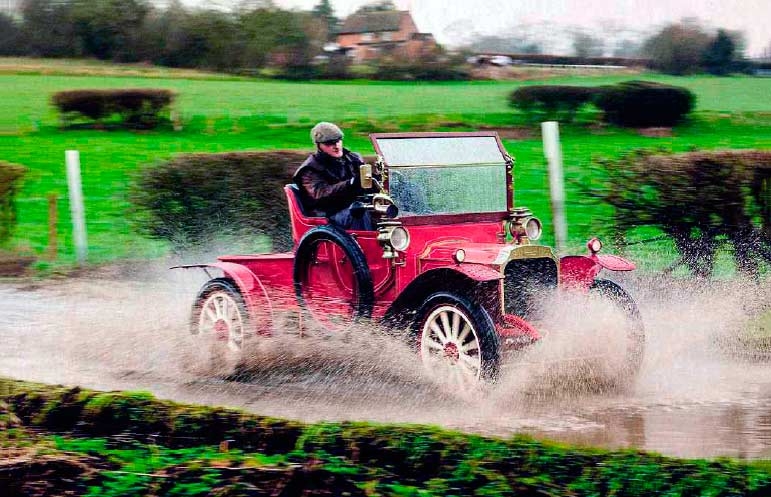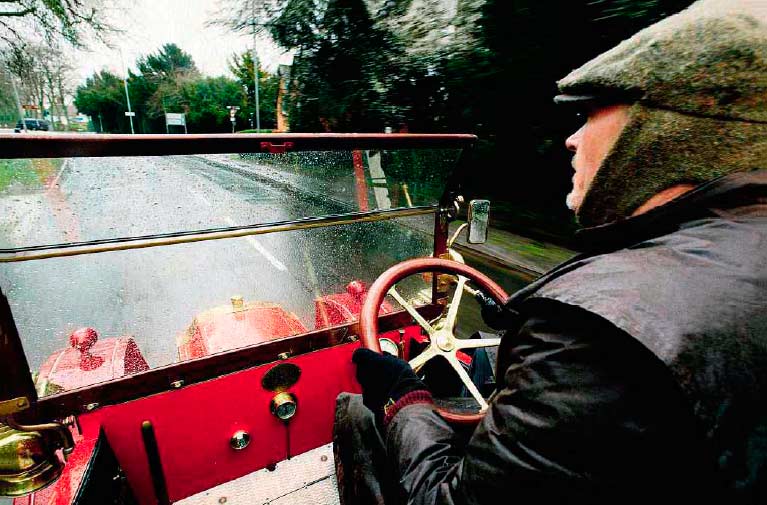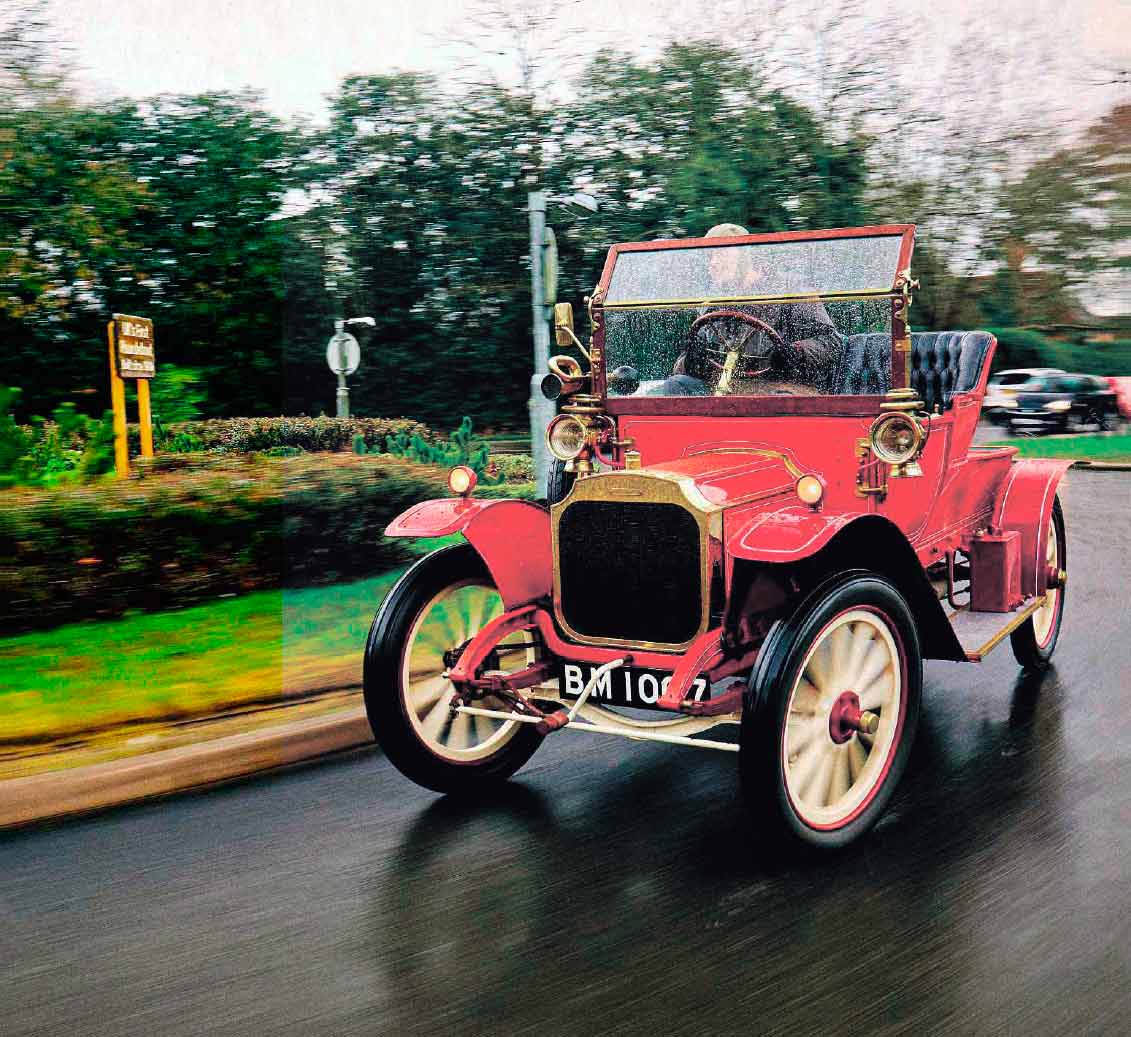
Coming full circle 1909 Vauxhall B-Type UK’s first roundabout in Luton’s finest. The UK’s first roundabout was built in 1909 – and it still exists. So what better way to pay homage than in a Vauxhall from the same year? Words Mark Dixon. Photography Matthew Howell.
1909 VAUXHALL B-TYPE
Roundabounts – they’re great, aren’t they? No obligation for unnecessary halts, no frustrating waits at red lights. You see a roundabout, you slow down, you check whether any traffic is approaching, and if all’s clear then you curve smoothly around the central circle and carry serenely on your way. Given the US’s predilection for four-way stops, it seems ironic that Columbus Circle in Manhattan, built in 1905, is credited as being the world’s first traffic roundabout. It was closely followed by the Place d’Etoile in Paris in 1907. But did you know that Letchworth, Hertfordshire, had the honour of hosting the UK’s first roundabout, which opened in 1909? It still exists, and it looks much the same as it did 108 years ago.

So, when Drive-My was offered a drive in the 1909 Vauxhall B-type belonging to its maker’s Heritage Collection – which is housed barely a dozen miles from the Letchworth roundabout – there was only one logical place to go.
Back in the day, the Vauxhall B-type was regarded as a ‘semi-racer’. That seems hard to believe on first acquaintance, its sit-up- and-beg proportions, bright red paint and shiny brass giving it a rather toy-like appearance: a Matchbox Model of Yesteryear come to life. A friend, being shown a picture of it later, asked whether it was ‘Bessie’, the Edwardian runabout driven by Dr Who in his Jon Pertwee incarnation. ‘Bessie’ was in fact made by a kit car company down in Dorset, but there’s definitely a resemblance.
As we’ll soon find out, however, the B-type is anything but toy-like. Designed at a time when Vauxhall was beginning to explore the publicity potential of hillclimbs, trials and races, this example predates the famous C-type ‘Prince Henry’ Vauxhalls by just one year and it can comfortably reach 50mph, despite having a relatively small 2.3-litre sidevalve engine.

This sporting reputation may explain why The Motor, which tested this very car in 1959, decided to try it out on the newly opened M1 motorway. They reported that ‘several vehicles [were] passed… It is far more suited to this road than to those that were in existence at the time of its manufacture.’
The one thing we certainly won’t be doing with the B-type, almost half-a-century later, is subjecting it to the ‘smart motorway’ lunacies of the M1 near Vauxhall’s Luton base. Instead, we’ve plotted a meandering route from Luton to Letchworth along country lanes and through villages that haven’t changed a lot since the B-type was new. But first we have to put ourselves in the mindset of a motorist from more than a century ago.
It’s raining when we begin our B-type road trip, and it will continue to rain all day. But maybe that’s appropriate. Cars then, as cars today, had to be used in all weathers. We’re about to put the little Vauxhall’s usability to the test, from Luton’s city traffic to the bumpy backroads of Bedfordshire.
Starting the engine from cold is straightforward, if a bit of a palava. First open the fuel tap below the rear-mounted petrol tank, before raising the bonnet so that you can lift the carburettor needle and prime the carb. Then, after checking the gearbox is in neutral, flick a switch on the firewall to turn on the ignition. Decompress the cylinders by turning a little brass tap above each exhaust valve cap, and pull the engine over on the starting handle to draw some charge into them.

Close the brass taps. Open the throttle slightly, by turning a knurled adjustment screw that’s cleverly linked to the accelerator pedal by a short rod. Then swing the handle, taking care to make sure your thumb is well clear in case the engine kicks back…
Without a trace of fuss, the side-valve four chunters into life and runs perfectly smoothly from cold. As it warms up, back the idle speed down using the knurled knob, and you’re good to go. Don’t worry about the advance/retard lever on the steering column: with modern fuel it makes little difference. But do keep an eye on the oil pressure gauge, set plumb-centre of the firewall. It reads up to 60psi but, with the sump containing monograde SAE 50 oil, the needle will go off the clock until engine heat thins the lubricant.
The gearbox is a three-speeder, with an H-gate ’change mounted outside the body, and a long handbrake lever next to it that works on the rear wheels. This lever is very useful for slowing the car ahead of junctions or down hills, because the foot brake operates contracting shoes on the gearbox tailshaft, and – as we’ll soon find out – working it hard produces some alarming noises. If you’re feeling especially confident, you can partially engage the ratchet on the outside lever to apply consistent braking force ahead of a junction, which frees up your right hand to make a downchange.
But let’s not get ahead of ourselves: first there’s the clutch to master. It’s a brass-on-steel cone, integral with the flywheel, and, while not quite being either in or out with nothing in-between, it needs some adept timing with left and right feet for a smooth getaway.
Learning the vagaries of the clutch, gearbox and brakes within the first mile or two of leaving the Vauxhall works was never going to be a stress-free experience, but the B-type soon wins you over with its willing performance and, yes, its comparative ease of operation. On skinny beaded-edge tyres inflated to 45psi, the steering is light and remarkably accurate – better now, it seems, than when the men from The Motor drove it: ‘We found [it]… necessitated a great deal of hard work,’ they grumbled.
The hardest part of changing gear is negotiating the Z-bend across the gate without looking down as you move from first (which is right and back) to second (left and forward), because you have to guess the gearlever’s position pretty accurately or it will jam against the gate and send your timing all to cock. Once moving, however, second and third are in the same plane, and they’re all you need unless you’re forced to a dead halt. Rather like driving a 21st Century electric car with regenerative braking, the skill of getting the best out of this 1909 machine is to anticipate junctions as accurately as possible so that you slow down but never need to stop.
When the motor tested the B-type in December 1959, it was a wet day but they reported that the windscreen ‘provides quite a degree of direct protection from rain’. At 6ft 1in I’m looking over the ’screen rather than through it, but at least I don’t have to worry about the lack of windscreen wipers.
What’s really impressive is how well the Vauxhall copes with the miserable conditions. Flooded roads have no impact on its Bosch magneto ignition, and even repeated runs through quite deep standing water for the benefit of photographer Matt don’t cause the engine to falter for a moment. It never overheats and never feels less than totally reliable.
The credit for that must go to Vauxhall Heritage’s restorers, Andy Boddy and Terry Forder, who are shadowing us in a rather funky early Frontera SUV. When we make a pit-stop at The Bird in Hand pub, a few miles before Hitchin, there’s a chance to quiz them about the car while our wet coats steam in front of the fire and we warm up with coffee.
‘It was found in a West Country scrapyard in 1949, and restored during 1952-1953,’ says Andy. ‘It’s the only survivor out of the 137 B-types that were built, but sadly we don’t know its early history. The body and engine were re-restored in the late 1990s, but today is the first time it’s been driven for six or seven years – the radiator was shot, and it’s just been totally rebuilt by Star Engineering in South Wales.’
Andy and Terry do an amazing job at the Heritage Centre, so now is an appropriate time to mention that the Centre’s open day – the one day in the year when members of the public can view Vauxhall’s collection – is on 10 June, the same date as the nearby Luton Festival of Transport. They deserve your support.
We’re the only customers at the pub on a wet weekday morning, so there’s still something of a timewarp feel as we saddle-up again in the B-type for the final push to Letchworth. I feel as though I have the car’s measure by now; on these narrow lanes it cruises comfortably at 35-40mph, and it picks up speed well on the flat. Going uphill, you just have to downchange into second and be patient while the sidevalve engine chugs faithfully away.
Downhill needs patience and caution: wet roads, skinny high-pressure tyres and rear-wheel-only brakes are not a happy recipe, and I have a slight ‘moment’ when the back tyres lock and slide sideways briefly. But we make it to Letchworth, and to our destination – the roundabout known as Sollershott Circus.
Letchworth’s proper title is Letchworth Garden City, and it has a fascinating history. It was a brand-new town, created in the early 1900s on what we would now call a green-field site to combine the advantages of countryside and city. The thinking behind it was heavily influenced by members of the Arts and Crafts movement and leading Quaker industrialists, and as a result it’s always had a reputation for being a bit hippyish. Not without some justification: one of its first buildings, the huge and fantasmagorical Cloisters, opened in 1905 as an open-air school for theosophical meditation, and Sir John Betjeman later wrote a poem mocking Letchworthians’ penchant for decorative leatherwork and morris dancing.
The irony is that, if Sir John were alive today, he would almost certainly be in thrall to Letchworth’s tree-lined suburban streets. Broadway, down which we’re trundling in the Vauxhall, is a perfect example, as wide as its name suggests and lined with prosperous Edwardian and 1920s villas. We can see our destination for hundreds of yards before we reach it; any lingering doubt is dispelled by tasteful wooden signs proudly boasting ‘UK’s First Roundabout. Built circa 1909’.
With an abundance of shrubs and low hedges, Sollershott Circus has an appropriately Edwardian appearance, although it has changed in size several times over the decades. It was originally fairly large, as shown in the early photo that heads this feature – with what could very well be a two-seater Vauxhall pottering past it – but that didn’t stop motorists driving the wrong way around it as late as the 1920s. By the 1930s, it had shrunk to a rather apologetic little traffic circle, with prominent ‘Keep Left’ signs to corral errant drivers onto the correct path.
More recently, the roundabout had to be remodelled again when it was chosen as a location for the 2013 film The World’s End, starring Simon Pegg and Nick Frost. The film makers wanted to stage a stunt in which a car launches itself over the roundabout, so all the existing shrubbery had to be removed, before being re-planted after the shoot.
The World’s End is, frankly, a strange movie in which a group of mates on an epic pub-crawl encounter an alien invasion. Paradoxically, thanks to the lofty ideals of Letchworth’s original planners, alcohol was banned from sale in the city centre until as late as 1958 and there have never been many pubs there, so the film company had to dress up other buildings to fulfil its necessary quota. A lack of places supplying alcohol is rarely a problem in British towns and cities, but it seems pleasantly appropriate for Letchworth. Over in Portland, Oregon, USA, there’s a popular bumper sticker that reads ‘Keep Portland weird’. Maybe the good citizens of Letchworth Garden City should have some of their own printed.
TECHNICAL DATA FILE SPECIFICATIONS 1909 Vauxhall B-type
Engine 2315cc in-line four, L-head configuration with side valves, Zenith 30mm carburettor
Power Rated at 18hp for taxation purposes / SAE gross
Transmission Three-speed manual, rear-wheel drive
Steering Worm and segment
Suspension Beam axles, semi-elliptic leaf springs
Brakes Rear-wheel drums operated by outside lever; transmission drum brake applied by foot pedal
Top speed c50mph
0-30mph c13sec
Above B-type rests on Broadway, in Letchworth Garden City, which still has an early 1900s feel to it.
Clockwise from top left Tall drivers must look over rather than through the ’screen; leaving the pub after suitable refreshment (coffee); approaching that roundabout in authentic vintage style.
Above and facing page Vauxhall’s 2.3-litre side-valve four is a willing and reliable performer, which proves unfazed by the kind of flooded roads that might tax a family car built in the 1950s.
‘Keep an eye on the oil pressure: the needle will go off the clock until engine heat thins the lubricant’
‘The skill is to anticipate junctions so that you slow down but never need to stop’





